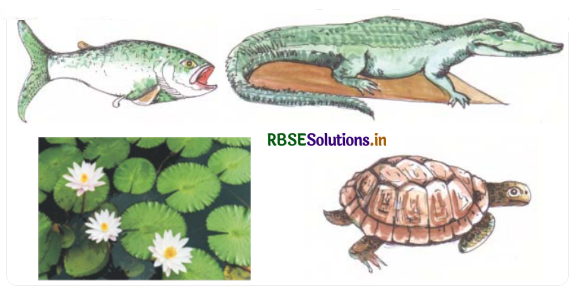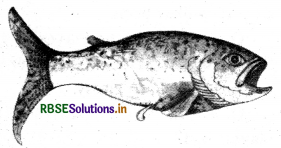RBSE Solutions for Class 5 EVS Chapter Chapter 11 Life in Water
Rajasthan Board RBSE Solutions for Class 5 EVS Chapter 10 Flow of Water Textbook Exercise Questions and Answers.
The questions presented in the RBSE Solutions for Class 5 EVS are solved in a detailed manner. Get the accurate RBSE Solutions for Class 5 all subjects will help students to have a deeper understanding of the concepts.
RBSE Class 5 EVS Solutions Chapter 11 Life in Water
RBSE Class 5 EVS Life in Water Textbook Questions and Answers
Explore and Answer the Following
Question 1.
Which are the organisms you have seen, that live in water?
Answer:
Crocodile, tortoise, fish, leech, etc.

Observe and Answer the Following

Question 1.
Which animals are seen in the above figure?
Answer:
Crocodile, fish and tortoise.
Question 2.
Out of them which are the animals that live only in water?
Answer:
Fish.
Question 3.
Which are the animals that live both on land and in water?
Answer:
Crocodile, tortoise,
Think and Answer These :
Question 1.
Make a list of the aquatic animals.
Answer:
(1) Fish
(2) Crocodile
(3) Tortoise
(4) Leech
(5) Aquatic snake
(6) Oyster etc.
Question 2.
Due to what reasons, some animals and plants are able to survive in wa¬ter?
Answer:
Only due to their special physical characteristics, animals and plants are able to sur¬vive in water.
Points for Discussion :
Question 1.
The animals that live on land like dog, cow, buffalo, keep their head out of the water while swimming. Why do they do so?
Answer:
The animals that live on land like-dog, cow, buffalo keep their head out of the water because they are unable to breathe in water. Hence, for breathing they keep their head out of the water.
Question 2.
How do fishes survive in water?
Answer:
Fish is able to remain safe in the water due to its specific shape (physical structure), glossy and thick skin.
Question 3.
Whom does their shape look like?
Answer:
The shape of a fish looks like a boat.
Question 4.
Which organizer found in the fishes, which help them to swim in water?
Answer:
Tail and fins.
Think and Write the Answers of the following :
Question
Draw a diagram of a ‘fish’ in your notebook.

Things to Do
Question 1.
Where is the algae found?
Answer:
Algae is found in areas where water remains accumulated.
Question 2.
Make a list of the plants that are found in water?
Answer:
- An Eichhomia Plant (Jalkhumbi)
- Lotus
- Algae
- Shirui Lily (Kumudini)
- Water chestnut (Singhara).
Question 3.
If the aquatic plants that are found in water are taken out of water, then what wil happen to them?
Answer:
If the aquatic plants are taken out of water, they will die.

Question 4.
If the plants that grow on land are grown in water, then what will happen?
Answer:
If they are grown in water, they will die.
Explore
Question 1.
Why the aquatic plants do not decay in water?
Answer:
Because the body structure of the plants is such that they can survive only in water.
Points for discussion :
Question 1.
Which is the plant completely submerged in water and how do its leaves look like?
Answer:
The plant which is completely sub-merged in water is an Eichhornia plant (Jalkumbhi), and it is green.
Question 2.
How do the leaves of the plant of flowing water, look like?
Answer:
The leaves of the plant of flowing water are narrow like ribbon.
Question 3.
How do the leaves of the plant floating on the surface of the water look like?
Answer:
Broad and glossy.
Question 4.
Why are the leaves of the lotus plant broad?
Answer:
They are broad so that they can main-tain balance and can survive by floating smoothly on the surface of water.
Question 5.
Why are the leaves of the plants of flowing water, very narrow like a ribbon?
Answer:
They are narrow like ribbon so that they don’t get damaged due to the flow of water, and they can float smoothly on the surface of water.
Points for Discussion
Question 1.
Which aquatic plant is shown in the pond?
Answer:
An Eichhornia plant (Jalkhumbhi).
Question 2.
If the entire pond gets covered with Eichhornia plant, then what will happen?
Answer:
Then, water in the pond will not be visible from outside, and the other aquatic or
Question 3.
What difficulties will the other aquatic aniamal and plants have if there is more growth of Eichhornia?
Answer:
If there is more growth of Eicchomia in the pond, then the other aquatic plants and organisms will not get any space to live in the pond, due to this no new plants will grow. The animals or other aquatic organisms will also have difficulty to live in the pond,
Learnt, understood and now tell
Question 1.
Name two aquatic animals.
Answer:
- Fish
- Crocodile.
Question 2.
Name two aquatic plants.
Answer:
- Eichhornia (Jalkhumbi)
- Lotus.
Question 3.
With the help of your teacher, observe any pond or step well in your nearby area and make a list of the aquatic animals and plants found in it.
Answer:
Aquatic Organisms
- Tortoise
- Fish
- Frog
- Leech
- Snail.
Aquatic Plants
- Water chestnut (Singhara)
- Eichhornia (Jalkumbhi)
- Lotus
- Algae
- Lily (Kumudini).
RBSE Class 5 EVS Life in Water Important Questions and Answers

Question 1.
Choose the right option :
(i) Fish is found in-
(a) field (b) hills
(c) water (d) deserts
Answer:
(c) water (d) deserts
(ii) Aquatic plant is-
(a) Wheat
(b) Parthenium (Gajarghas)
(c) Marigold
(d) Chestnut (Singhara)
Answer:
(d) Chestnut (Singhara)
Question 2.
Fill in the blanks
(a) We see many types of plants and ............... around us.
(b) The effect of the ............... is clearly visible in the structure of every plant and animal.
(c) If we work for a long time in water, then the skin of our fingers become ...............
(d) ............... spreads very fastly, so the entire pond is covered.
Answer:
(a) animals
(b) surroundings
(c) wrinkled
(d) An Ei chhomia plant (J alkhumbi)
Question 3.
Match Table A with Table B :
table 1
|
Table A |
Table B |
|
Aquatic animal |
small plants |
|
Aquatic plant |
Fins |
|
Fish |
Tortoise |
|
Algae |
Jalkhumbi (Eichhomia) |
Answer:
|
Table A |
Table B |
|
Aquatic animal |
Tortoise |
|
Aquatic plant |
Jalkhumbi (Eichhomia) |
|
Fish |
Fins |
|
Algae |
Small plants |
Question 4.
State True/False.
(i) Plants and animals are also found in water.
(ii) Bears are also found in snowy area.
(iii) Lotus is not an aquatic plant.
(iv) Algae are such small plants that grow in water only.
(v) Aquatic animals and plants breathe in water only.
Answer:
(i) True
(ii) True
(iii) False
(iv) True
(v) True.
Very Short Answer Type Questions
Question 1.
Effect of what is seen on the structure of animals and plants?
Answer:
Effect of their surroundings.
Question 2.
What does a bear have on its body that protects it from very cold weather?
Answer:
It has very long hair on its body.
Question 3.
What are those plants called which survive only in water?
Answer:
Aquatic plants.
Question 4.
What are the animals which live in water called?
Answer:
Aquatic animals.
Question 5.
Do the plants grow in flowing water also?
Answer:
Yes.
Short/Long Answer Type Questions
Question 1.
At which places are the plants and the animals living on the land found?
Answer:
Of the plants and animals that live on land, some of the plants and animals are found in the mountains, some on the plains, and some in the deserts.

Question 2.
How are the plants and the animals, able to live (survive) in specific environment?
Answer:
Due to their physical characteristics only, the plants and the animals are able to live in specific surroundings.
Question 3.
What is adaptation?
Answer:
The aquatic animals and plants can live in water due to some special physical characteristics. This is known as adaptation.
Question 4.
Mention the types of aquatic plants on the basis of their submergence in the water.
Answer:
There are two types of aquatic plants on the basis of their submergence in the water:
- The plants which remain completely sub¬merged in the water.
- The plants which remain half submerged in the water but their leaves keep on floating on the surface of the water.
Question 5.
How many types of aquatic plants are there on the basis of floating in water?
Answer:
- The plants which grow in flowing water.
- The plants which grow in stagnant water.
Question 6.
Why is the Eichhornia plant (Jaikhumbi) has be removed from time to time from the ponds?
Answer:
Eichhornia plant spreads very fast in the ponds or lakes, etc. pn its own without plant-ing it or taking care of it. It covers the water surface of the entire pond, due to this the other plants which grow in water, and the organisms (animals) living in the water don’t get enough space to survive. Therefore it is necessary to remove it from time to time.
Question 7.
Mention some features of aquatic plants.
Answer:
Features of aquatic plants :
- The aquatic plants are tender.
- Stems of the aquatic plants are holllow and filled with air.
- The leaves of aquatic plants are green and flat, and their surface has wax-like which flourish substance which helps them to flourish in water without developing wrinkles.

Question 8.
Following are the plants which flourish on land or in water. Separate them. Eichhornia plant (Jaikhumbi), Marigold, Neem, Lotus,Water Chestnut (Singhara), Rose, Algae, Mango, Khejari, Lily (Kumudini).
Answer:
|
Aquatic plants |
Plants flourishing on land |
|
Eichhomia (Jalkumbhi) |
Marigold |
|
Lotus |
Neem |
|
Water Chestnut (Singhara) |
Rose |
|
Algae. |
Mango |
|
Lily (Kumudini) |
Khejan |

- RBSE Solutions for Class 5 EVS Chapter 10 Flow of Water
- RBSE Solutions for Class 5 EVS Chapter 3 We are Special
- RBSE Solutions for Class 5 EVS Chapter 10 जल ऊपर से नीचे की ओर
- RBSE Solutions for Class 5 EVS Chapter 6 बीज बना पौधा
- RBSE Solutions for Class 5 EVS Chapter 7 Magnificence of Trees
- RBSE Solutions for Class 5 EVS Chapter 11 जल में जीवन
- RBSE Solutions for Class 5 EVS Chapter 6 Seed Becomes Plant
- RBSE Solutions for Class 5 EVS Chapter 8 The Unique World of Insects and Animals
- RBSE Solutions for Class 5 EVS Chapter 1 Understanding Our Relations
- RBSE Solutions for Class 5 EVS Chapter 2 Migration of Families
- RBSE Solutions for Class 5 EVS Chapter 9 Sources of Water